December 19-26, 2001
The Big Travelogue: Part Fifteen
There's nothing like a good road trip to get a feel for the
state of radio these days. From June 23 until July 7, your editor
(accompanied by Boston Radio Archives creator Garrett Wollman)
hit the road to see what's on - and in - the air across a broad
swath of mid-America.
For the next few installments of Site of the Week, we'll be
recapping the many highlights of what we like to think of as
The Big Trip, 2001 edition. Come along...
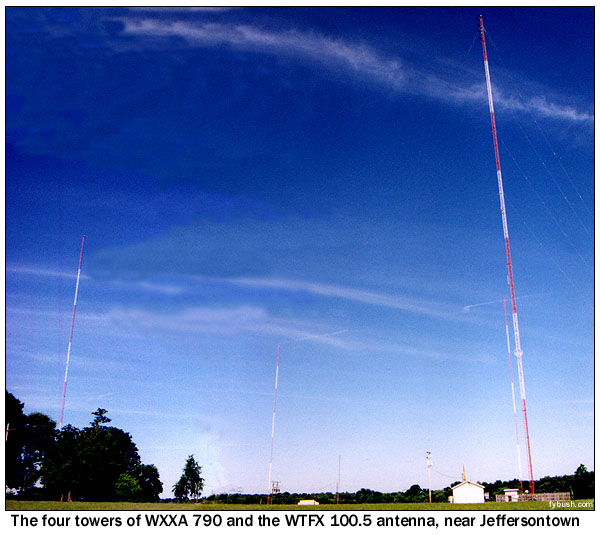 Click here for part
one Click here for part
one
Click
here for part two
Click
here for part three
Click
here for part four
Click
here for part five
Click
here for part six
Click
here for part seven
Click
here for part eight
Click
here for part nine
Click
here for part ten
Click
here for part eleven
Click here for
part twelve
Click here for
part thirteen
Click here for
part fourteen
Friday, July 6 - We're driving across southern Indiana,
in a hurry to spend a few too-short hours checking out the sites
in Louisville, Kentucky, a market deserving of an entire day
to itself. Unfortunately, the schedule (and our impending return
to real life) intervenes, and we're forced to do the whole thing
in just an afternoon. Still, that's enough time to at least capture
the highlights of this gracious city.
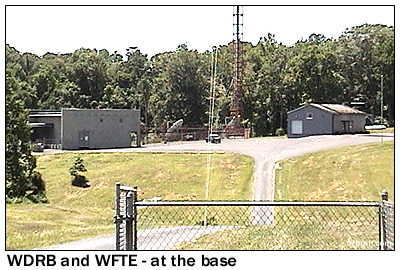 Any
tour of Louisville broadcasting has to begin on the Indiana side
of the Ohio River, in some of the hilliest terrain the Hoosier
State has to offer. Any
tour of Louisville broadcasting has to begin on the Indiana side
of the Ohio River, in some of the hilliest terrain the Hoosier
State has to offer.
This area, a pleasant rise of land just northeast of the I-265
loop that surrounds the Louisville metro, is known as "Floyds
Knobs," and it's home to most of the city's TV and FM broadcasters.
Our visit, following a quick lunch just off I-265, begins
where Spickert Knob Road rises, 900 or so feet above sea level,
to meet Skyline Drive near the crest of this north-south ridge.
Here we see the southernmost of the Floyds Knobs towers: nearly
a thousand feet of steel that carries Fox affiliate WDRB (Channel
41) and UPN affiliate WFTE (Channel 58). A sign at the entrance
to the transmitter buildings suggests that WFTE's official studio
address is up here as well.
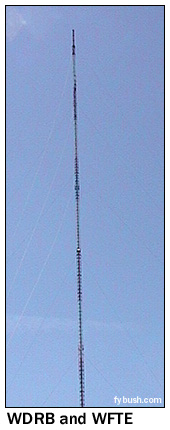 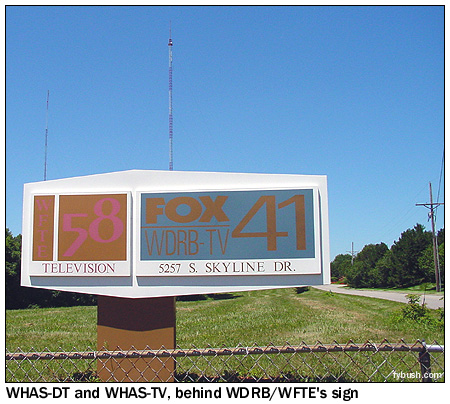 Looking
just a bit to the north up Skyline Drive, we can see the tall
tower that's home to the Louisville area's ABC affiliate, WHAS-TV
(Channel 11). Looking
just a bit to the north up Skyline Drive, we can see the tall
tower that's home to the Louisville area's ABC affiliate, WHAS-TV
(Channel 11).
A shorter aux stick to the west is apparently where WHAS-DT
(Channel 55) transmits, but without a mobile DTV receiver, it's
hard to be certain who's actually on the air with digital TV
signals.
(But hey, that's part of the excitement of surveying the broadcast
scene at this interesting transitional moment in technological
history, isn't it -- sort of like driving the FM signals of,
say, 1942!)
The WHAS building appears unexciting as we drive past, so
we head north on Skyline, to a spot where it bends to the east
and presents us with a nifty panorama of towers.
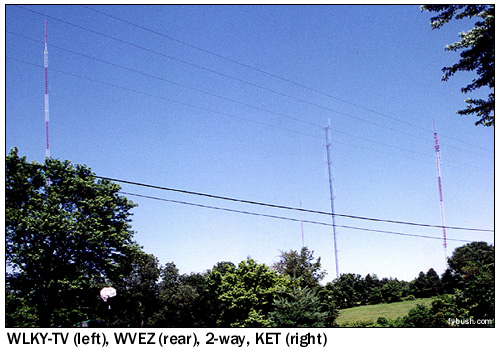 Just
north of the road, behind gated access roads, we see (from west
to east) WLKY-TV, the CBS affiliate on channel 32 (with DTV on
26); far to the north, WVEZ (106.9), with two bays on a mast
at the top of its towers; an unpainted stick festooned with two-way
antennas; and the tower shared by Kentucky Educational Television's
two Louisville outlets. Just
north of the road, behind gated access roads, we see (from west
to east) WLKY-TV, the CBS affiliate on channel 32 (with DTV on
26); far to the north, WVEZ (106.9), with two bays on a mast
at the top of its towers; an unpainted stick festooned with two-way
antennas; and the tower shared by Kentucky Educational Television's
two Louisville outlets.
WKMJ (Channel 68) was the original KET station here, but some
years back, KET merged its operations with the Louisville Public
Schools' own educational station, WKPC (Channel 15).
KET's main service moved down the dial to channel 15, and
channel 68 became the broadcast flagship of "KET2,"
a secondary service seen in the rest of the Bluegrass State via
cable TV providers. The KET tower is also home to a construction
permit for WBNA (Channel 21), the WB affiliate that currently
transmits from the southern side of the market on a tower we
don't have the time to see this trip.
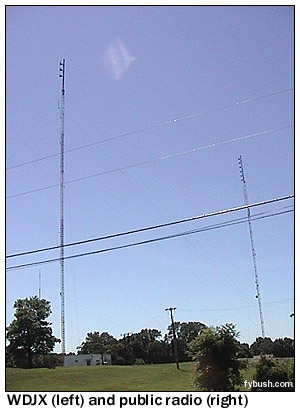 Across
the street to the south, we see a bunch of FMs. WDJX (99.7) is
on the taller one to the left; on the right, six FM bays are
shared by an interesting group of public radio operators. Across
the street to the south, we see a bunch of FMs. WDJX (99.7) is
on the taller one to the left; on the right, six FM bays are
shared by an interesting group of public radio operators.
There are three public FMs in Louisville, and until a few
years ago, two public radio operators.
The University of Louisville put WUOL (90.3) on the air in
1976 as the second classical station in the market. It joined
a noncomm scene that already included two entries from the Louisville
Public Library, news-talk WFPL (89.3), on the air since 1950,
and its younger cousin, classical WFPK (91.9), on the air since
1954.
In 1993, the three stations incorporated the Public Radio
Partnership, and by 1996 they had coordinated their formats to
eliminate duplicate programming and fundraising. WUOL kept the
classical format, while WFPL took all the NPR and PRI news and
talk offerings. That freed WFPK to try something new, becoming
"Radio Louisville," offering a diet of AAA music, bluegrass
and jazz. We enjoy tuning it in as we drive around for the rest
of the afternoon...
What we don't enjoy, particularly, is the encounter we have
with one of the locals as we're taking these Floyds Knobs pictures.
Unsurprisingly, the folks who live on these rural ridge-top roads
suffer a lot of interference to their TV and FM reception, and
they harbor deep grudges indeed. In the case of the gentleman
who approaches us as we're taking our pictures, it seems to have
devolved from a deep grudge to an irrational paranoia, though!
Despite (or perhaps because of?) the Maine plates and our
very casual dress, our new friend is absolutely convinced we're
from the government and there to investigate a link between these
towers and cancer. He's also certain that we know much more than
we're telling him, and that we're going to somehow generate a
report that he won't be allowed to see. Sir, we didn't get your
name - but here's the report, and as you can see, we were telling
you the truth, even as you kept screaming at the car while we
drove off!
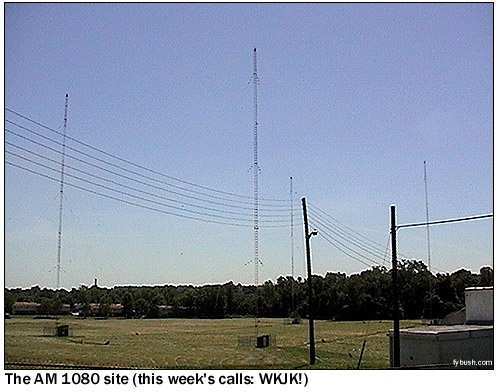 Anyway...we head
down from the ridge into New Albany, Indiana, where we find our
first Louisville AM. Anyway...we head
down from the ridge into New Albany, Indiana, where we find our
first Louisville AM.
The 1080 station has been through many, many calls in the
last few years, including a stint as a simulcast of WDJX-FM.
At the moment, it's doing syndicated talk and standards as one
of many Clear Channel outlets in this market, under the calls
WKJK.
It's four towers, in any event, cranking out 10 kilowatts
by day and a kilowatt at night from this site on Daisy Lane,
sending its signal south-southeast towards Louisville (while
nulling towards Dallas and Hartford, of course!)
New Albany is also home to a 1570 station, WXLN, but we don't
see its single tower on this trip.
Instead, we wind our way through traffic in downtown New Albany
and head east to Jeffersonville, Indiana, for our last Hoosier
stop of this trip.
 The 970 outlet that
uses these two towers with 5 kilowatts day and night has a long
history in the market, largely under the heritage calls WAVE. The 970 outlet that
uses these two towers with 5 kilowatts day and night has a long
history in the market, largely under the heritage calls WAVE.
Those calls disappeared a few years back, though, and since
then the station has enjoyed several identities, including one
as news-talk WLKY (sister to TV channel 32) and as WAVG, continuing
the heritage of "WAVE" even after those calls were
relegated to TV-only use on the NBC affiliate, channel 3.
A few months before our visit, though, Hearst-Argyle sold
WLKY radio to Salem, and now the signal at 970 is cranking out
conservative talk from Salem's network under the calls WGTK,
which we remember from Middlebury, Vermont a few years back.
The WAVG calls, meanwhile, have landed on the Jeffersonville-licensed
1450 signal, which is using them with a classic country format
that sounds pretty good despite the limited signal reach of that
nondirectional kilowatt.
It's time for us to enter Kentucky for the second time this
day, though, so we point the rental car south on I-65 past downtown
Jeffersonville and over the bridge into downtown Louisville.
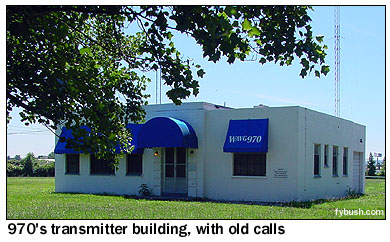
As we make that drive, we're airchecking some of the stations
that we won't have time to see this day. At the bottom of the
Louisville dial is WTMT (620), with ESPN sports from a site east
of I-65 on the Indiana side. WJIE (680) from Newburg does gospel;
WFIA (900) has more religion on its little signal (1000 watts
day, 163 watts at night!) from the east side of Louisville, along
the river; WLLV (1240) is still more gospel from just east of
downtown; and WLOU (1350) is WLLV's sister station, also running
religion from what appears to be a three-tower site west of Louisville.
We'll have to hit all of those next time we visit Louisville,
though; for now, there's time just for some quick highlights
before we're due to head east towards Frankfort, Lexington and
dinner. First up is a drive past the downtown tower that's home
to the 102.3 signal that was once progressive WLRS ("the
Walrus") but is now urban AC WULV ("Love 102")
under Radio One ownership. We see it as we park to get a shot
of the most famous studio site in Louisville: 520 West Chestnut,
the WHAS building.
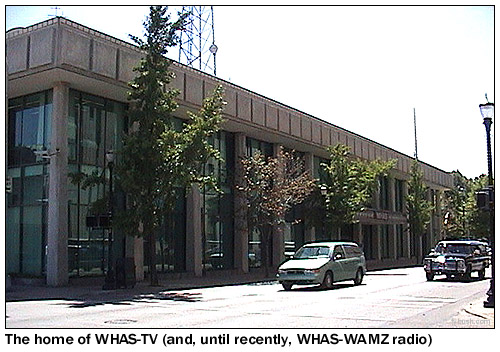 The building at Fifth
and Chestnut is home only to WHAS-TV these days, though; the
radio and TV stations split ownership a few years back, with
TV going to Belo and radio to Clear Channel, and it's been more
than a year since Clear Channel moved all of its many Louisville
properties to an office park on the edge of town. The building at Fifth
and Chestnut is home only to WHAS-TV these days, though; the
radio and TV stations split ownership a few years back, with
TV going to Belo and radio to Clear Channel, and it's been more
than a year since Clear Channel moved all of its many Louisville
properties to an office park on the edge of town.
Still, it's an impressive building, and a reminder of the
long heritage of this old-line radio station. We pause for a
moment to recall all the great music we used to hear on WHAS
late at night, emanating from the basement of this very building,
and then continue through downtown (including Muhammad Ali Boulevard,
named for Louisville's most famous native) to the next TV destination
on the agenda, over at 725 South Floyd Street on the other side
of I-65. This is another case of a TV station that's parted ways
with its radio heritage: WAVE-TV (Channel 3), the market's NBC
affiliate. (WHAS was CBS for most of its existence, switching
to ABC a few years back and causing a reciprocal switch at WLKY,
channel 32.)
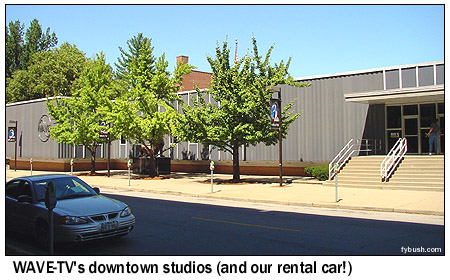 At first, we can't
even see the WAVE building from the corner of Broadway and Floyd,
just a sort of triangular canopy with a channel 3 sign (Garrett
notes the similarity of the WAVE logo to the WFSB Hartford and
WCAX Burlington "3" logos) that leads to a walkway
into the WAVE studios. At first, we can't
even see the WAVE building from the corner of Broadway and Floyd,
just a sort of triangular canopy with a channel 3 sign (Garrett
notes the similarity of the WAVE logo to the WFSB Hartford and
WCAX Burlington "3" logos) that leads to a walkway
into the WAVE studios.
As we continue down Floyd, though, we find the "front"
entrance at the back of the building. This is one of the few
photos that shows the trusty Grand Am that carried us halfway
across the country; it also shows the old "WAVE" logo
at left, complete with a stylized wave.
WAVE radio, as we noted earlier, is long gone, becoming today's
WGTK 970.
From here, we make our way through downtown traffic to the
northeast side of town, just south of the Ohio River,where we
find Mellwood Avenue. Up on a hill, at number 1918, is the third
"major" TV station in town, WLKY-TV. Under Hearst-Argyle
ownership, this former also-ran has become a serious market player,
complete with the standard Hearst-Argyle graphics and news music.
And you've got to love that helicopter...
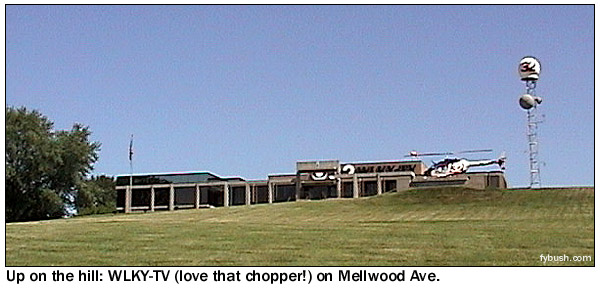
From here, it's time to hit the real highlights that close
out our visit to Louisville. We head east on I-64 to the I-265
loop out in the far eastern suburbs and hop south one exit to
route 155, and after a quick stop for gas at the corner of Tucker
Station Road, we're on our way to the four tall sticks seen at
the top of the page.
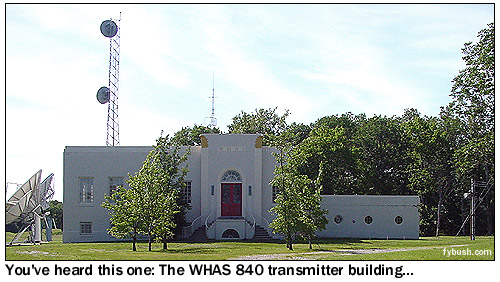 Those
belong to another Louisville oldtimer, the station variously
known as WAKY (in its big top-40 days) and WWKY (more recently). Those
belong to another Louisville oldtimer, the station variously
known as WAKY (in its big top-40 days) and WWKY (more recently).
Under Clear Channel ownership, that 790 signal (sending 5
kilowatts south-southeast towards Lexington and north-northwest
towards Louisville by day, and 1 kilowatt west-northwest towards
Louisville by night) became an all-sports signal, and just a
few weeks before we pulled up it changed calls to WXXA as "Fox
Sports 790."
WXXA, of course, is a callsign we know much better back east
from the Fox TV affiliate on channel 23 in Albany, but since
WXXA-TV is also owned by Clear Channel, the call-sharing is at
least understandable.
One tower in this array is also home to Louisville rimshotter
WTFX (100.5), still another Clear Channel property; you can see
its bays at the top right of the photo at the top of the page.
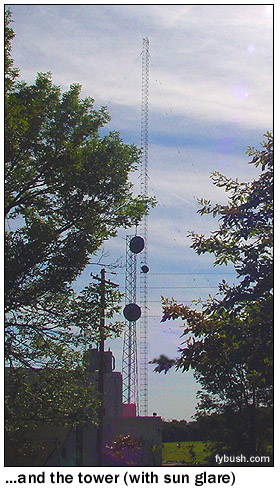 And then, of course,
came the real thrill of this Louisville excursion: back out to
I-265, north for two exits, past I-64 to US 60, and then a few
miles east to the little hamlet of Eastwood and north on Flat
Rock Road. And then, of course,
came the real thrill of this Louisville excursion: back out to
I-265, north for two exits, past I-64 to US 60, and then a few
miles east to the little hamlet of Eastwood and north on Flat
Rock Road.
It's there that we find the Louisville station everyone can
list in his or her DX log: the mighty 50 kilowatts of WHAS (840),
complete with one of the most graceful looking transmitter buildings
we've ever seen.
Unfortunately, the sun is at precisely the wrong angle this
late (5 o'clock) in the afternoon to get a very good picture
of the tower, but then this doesn't look like an original piece
of steel, either: it's unpainted and apparently strobe-lit. There's
no sign of sister FM outlet WAMZ (97.5), which has an application
to move to this site.
(One major tower that we miss completely is WAVE-TV; they're
far to the northeast of the city along the I-71 corridor, and
we're just not going that way; they make up for the omission
with a nice aerial view of their very tall tower in their station
ID announcement much later that night, though!)
Having properly admired WHAS, and vowing to return some morning
when we can see the tower better, we pull back out to US 60 and
head east towards I-64 and our overnight stop in one of America's
smallest state capitals, Frankfort.
We check into our motel and set up the VCRs to roll on Louisville
and Lexington news (having deliberately chosen a spot where the
cable system gets both!), then head off for a quick exploration
of this little town.
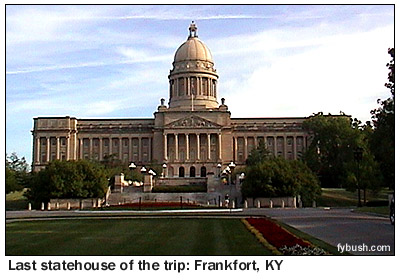 The
statehouse isn't hard to find; it's by far the largest structure
in town, as you'd expect from a place where the state government
is by far the largest employer. The
statehouse isn't hard to find; it's by far the largest structure
in town, as you'd expect from a place where the state government
is by far the largest employer.
Downtown is cute, too, though we're not sure we actually saw
the building that houses the local radio stations. WKED (1130)
and WFKY (1490) make up the AM dial, with WKED-FM (103.7) and
WKYW-FM (104.9) on the FM side, and it's not hard at all to see
all their sites at once.
We'd been warned by a fellow tower hunter that the site listed
for WFKY, on the west side of the river across from downtown,
was vacant, and we'd also noted a CP for WFKY to diplex with
WKED, so we had a feeling we'd find both at the same place.
Indeed, a turn west on state route 1005 from US 127 on the
west side of town soon brought us to a prefab home, and behind
that, the two towers of WKED and now WFKY as well.
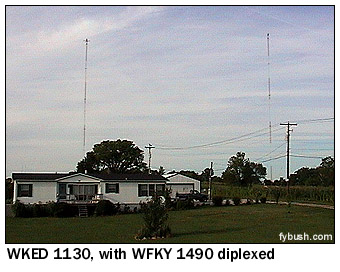 WKED
uses both towers for its 500-watt day signal, sending most of
its energy southeast towards downtown; WFKY uses one of them
(we're not sure which!) for its 1000-watt fulltime signal. WKED
uses both towers for its 500-watt day signal, sending most of
its energy southeast towards downtown; WFKY uses one of them
(we're not sure which!) for its 1000-watt fulltime signal.
When we were there, WKED was running satellite standards (and
we didn't hear anything that sounded like a legal ID, either!),
while WFKY and WKYW-FM were simulcasting news-talk. A few months
later, Clear Channel bought them both, along with the FMs, and
we hear there have been format changes since then.
Somewhere along the way, we passed little stations like WKXF
(1600) in Eminence, WCND (940 Shelbyville) and their ilk; we
hear a few from Frankfort, but the magnificent ground conductivity
we were experiencing a week ago in the upper midwest is long
gone, and the rockier soil hereabouts doesn't carry AM signals
as well.
That said, we're getting good signals on most of the Lexington
dial from Frankfort, and with the promise of a nice dinner awaiting
us (thanks, Mr. Wollman!), we call the tower-hunting quits for
the night and set off for Lexington, food, and the anticipation
of one more day on the road.
You'll read all about that very long day, including Lexington,
Cincinnati, and more, next week here at Tower Site of the Week...see
you then!
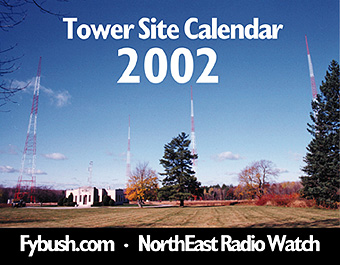 Meanwhile...you
can still enjoy the Big Trip's lovely KFAB view and eleven more
favorites from Tower Site of the Week all year long, if you order
the Tower Site 2002 Calendar! Meanwhile...you
can still enjoy the Big Trip's lovely KFAB view and eleven more
favorites from Tower Site of the Week all year long, if you order
the Tower Site 2002 Calendar!
This full-color, 8.5-by-11 inch, glossy calendar features
a dozen exciting tower images, and it can be on your wall for
just $15, postpaid! (NY residents include sales tax; US$20 postpaid
to Canada).
Click here to see a sample
page!
You can have yours for the holidays - and our ordering deadline
has been extended, so it's not too late to send your check or
money order, payable to Scott Fybush (that's me), to 92
Bonnie Brae Ave., Rochester NY 14618.
Your purchase of a calendar helps keep Site of the Week coming
all year round...thank you!
|
